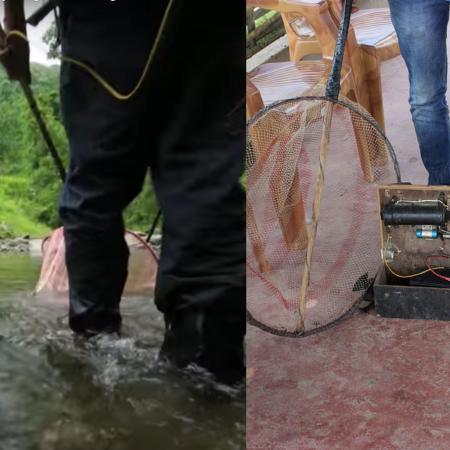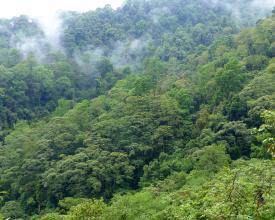
Fortalecimiento de la conservación comunitaria en un punto crítico de biodiversidad GANADOR DEL PREMIO PATHFINDER 2021

En los tres pueblos de Sukhai, Kivikhu y Ghukhuyi, en Nagaland, se puso en marcha un proyecto piloto cuyo objetivo era crear y vincular Áreas Conservadas por la Comunidad (ACC) en todo el paisaje y apoyar la conservación mediante la creación de medios de subsistencia. El modelo adoptado pretendía reforzar la resiliencia de las comunidades rejuveneciendo las prácticas tradicionales de conservación y proporcionando medios de vida suplementarios. Las actividades incluían la recopilación de conocimientos indígenas, la sensibilización sobre la conservación del paisaje y la capacitación de las comunidades en documentación y seguimiento de la biodiversidad, así como la promoción del ecoturismo como medio de vida. En la actualidad, el proyecto ha dado resultados positivos en términos de uso sostenible de los recursos biológicos mediante la adopción de la sostenibilidad a largo plazo, la mejora de la gobernanza y la conservación eficaz del paisaje. Este modelo se está integrando en el mecanismo de gobernanza y se está ampliando a través de un enfoque múltiple que incluye apoyo financiero y reconocimiento legal.
Contexto
Défis à relever
En Nagaland, aunque las prácticas tradicionales de conservación han ayudado a proteger la biodiversidad, y hay constancia de que se declararon ACC a principios del siglo XIX, especialmente en respuesta a la degradación de los bosques y la pérdida de vida salvaje, estas ACC se enfrentan a numerosos retos en su creación, eficacia y sostenibilidad, y requieren esfuerzos sostenidos para su conservación. El principal reto al que se enfrenta el 81% de las ACC es proporcionar medios de vida alternativos. Además, estas CCA son densas manchas aisladas de bosque y es necesario garantizar la conservación de grandes zonas forestales contiguas permitiendo la formación de CCA gestionadas conjuntamente.
Ubicación
Procesar
Resumen del proceso
Los campeones locales consiguen motivar a las comunidades para que inicien y continúen las actividades relacionadas con la conservación. La documentación de la biodiversidad local a través de los Registros Populares de Biodiversidad ayuda a codificar los conocimientos orales y a conocer mejor la bidoiversidad. Los medios de subsistencia alternativos en forma de ecoturismo ayudan a los jóvenes, a los grupos de mujeres y a los cazadores tradicionales de la comunidad a mejorar sus ingresos familiares.
Bloques de construcción
Campeones locales
Contar con campeones locales es clave para dar impulso a la iniciativa y para que las comunidades se apropien de ella. Inicialmente se celebraron varias reuniones con las comunidades de los tres pueblos piloto para concienciarlas de la amenaza ecológica inminente y de las ventajas de los enfoques integrados a nivel comunitario y de las partes interesadas para gestionar los recursos de forma colectiva y eficaz. Durante estas deliberaciones, se identificaron campeones locales en cada pueblo. Aunque se presentaron muchas personas interesadas, fueron Ivan Jimo, del pueblo de Sukhai, K. Vikuto Zhimomi, del pueblo de Ghukhuyi, y Kakishe Muru y Bokato Muru quienes estuvieron en contacto permanente con nosotros, se interesaron por lo que ofrecía el proyecto y, lo que es más importante, comprendieron las razones que lo impulsaban. Les pusimos en contacto con líderes de comunidades afines que llevaban a cabo actividades de conservación similares en el noreste de la India. Hubo transferencia de conocimientos cuando invitamos a otros líderes comunitarios al CCA y organizamos el viaje de nuestros campeones locales para que presenciaran otros casos de éxito. También los hemos involucrado en varias plataformas en línea y fuera de línea en las que podían hablar de sus iniciativas de conservación.
Factores facilitadores
Con el fin de apoyarles y motivarles, mantuvimos una comunicación abierta con ellos para afrontar todos los retos del camino. La motivación continua por nuestra parte fue uno de los factores que propiciaron que los campeones locales movilizaran a los miembros de la comunidad y explicaran conceptos y problemas de forma sencilla, con ejemplos fáciles de entender con los que la gente se identificara.
Lección aprendida
La implicación de las comunidades, a través de promotores locales y estimulando las iniciativas locales, ha sido clave para integrar con éxito la naturaleza en el desarrollo sostenible y aumentar la concienciación sobre la sostenibilidad.
Sobre la base de toda esta exposición, los promotores locales, como parte de su propia organización de base y sin la ayuda del TERI, han presentado su primera propuesta independiente al proyecto financiado por el PNUD y el Ministerio de Medio Ambiente, Bosques y Cambio Climático de la India titulado "Otras medidas eficaces de conservación basadas en la zona (OECM)", orientado a ayudar a estas comunidades.
Medios de vida alternativos vinculados a la conservación
El desarrollo de medios de vida alternativos vinculados a la conservación es el salvavidas de las iniciativas de conservación que soportan cargas financieras.
La idea de iniciar el ecoturismo como medio de vida alternativo surgió mientras realizábamos estudios sobre la biodiversidad. Observamos que las comunidades, especialmente los cazadores y los jóvenes, tenían buen ojo para detectar la vida salvaje, así como un buen conocimiento del bosque en general. Fue entonces cuando los jóvenes recibieron formación de expertos en documentación de flora y fauna. Los avistamientos se anotaron en registros de campo, lo que creó una comunidad de conservacionistas entre los jóvenes. Al documentar fauna única, rara o especial, estos estudios sirvieron de catalizador para atraer a ecoturistas de todas partes.
Así, los jóvenes, junto con los cazadores que dependen de la caza para subsistir de las tres aldeas piloto, fueron seleccionados y formados como guías de la naturaleza con otras formaciones en asociación con Air BnB y Titli Trust sobre higiene y cuidado del medio ambiente en casas de familia, seguridad y protección, servicio de limpieza y servicio de comida y bebida, maximización de las ventas y gestión del dinero, y marketing de bajo coste.
A través de un sitio web y de anuncios en grupos de entusiastas de las aves y las mariposas de la India, se organizaron encuentros sobre biodiversidad para atraer ecoturistas y promover el ecoturismo.
Factores facilitadores
No sólo la presencia de los visitantes contribuyó a impulsar el ecoturismo basado en la naturaleza, sino que las evaluaciones de la biodiversidad aumentaron los conocimientos sobre la biodiversidad faunística.Los visitantes participaron en los estudios de biodiversidad, se alojaron en casas de familia locales en los pueblos de Sukhai y Khivikhu, degustaron la suntuosa cocina local, presenciaron las danzas tradicionales de Sema y se relacionaron con la comunidad local para conocer sus actividades de conservación de los recursos naturales.
Lección aprendida
La formación de los jóvenes en evaluación de la biodiversidad y uso sostenible de los recursos naturales, así como la formación y capacitación de los miembros de la comunidad local como guías naturales para el ecoturismo, ha dado como resultado una mejora de las oportunidades de subsistencia con el flujo constante de turistas que visitan esta zona para avistar "especies especiales de aves y mariposas". Ahora las comunidades se enorgullecen de conservar activamente la biodiversidad local y el paisaje en general. Muchas de las especies que eran raras de ver han reaparecido gracias a que las comunidades siguen patrullando y conservando su CCA.
Sin embargo, se trata de paisajes muy remotos con muy poca conectividad por carretera, por lo que, a pesar de su enorme biodiversidad y de los alojamientos artesanales, muy pocos ecoturistas, más bien los únicos interesados en visitar estas zonas son los observadores de aves o los entusiastas de las mariposas. En el futuro, si se mejora la conectividad por carretera, las comunidades locales tendrán más oportunidades de ganar dinero y de promover el ecoturismo. Esto ha motivado aún más a las comunidades, incluidas las de los pueblos vecinos, a dedicarse a la conservación y proteger sus recursos naturales.
Conocimientos ecológicos autóctonos
Aprovechar los conocimientos tradicionales y las ricas tradiciones culturales y el patrimonio biológico de las comunidades locales les hace sentirse orgullosas de su patrimonio y mejora los resultados de la conservación. La documentación de los derechos de obtentor por la aldea de Sükhai fue un excelente punto de partida para mejorar la conservación.
Factores facilitadores
Los derechos de obtentor elaborados para los tres pueblos de Sukhai, Kivikhu y Ghukhuyi documentan el folclore, los conocimientos tradicionales, la ecología, la biodiversidad y las prácticas culturales de los lugareños y ayudan a codificar los conocimientos orales de las comunidades.
Lección aprendida
Con el tiempo, los conocimientos tradicionales se han erosionado y se están perdiendo el folclore y las prácticas que sustentaban el uso racional de sus paisajes. Los ancianos se mostraron satisfechos con la documentación de sus conocimientos tradicionales y culturales indígenas en los Registros Populares de Biodiversidad (RPB).
Impactos
Se han documentado y protegido unas 222 especies de aves y 200 especies de mariposas mediante la declaración de 939 hectáreas como reserva de conservación comunitaria y la prohibición de la caza y la pesca destructiva en el resto de bosques y ríos (con una superficie total de 3.751 hectáreas).
Los beneficiarios directos hasta ahora han sido 1.200 personas de 3 pueblos, mientras que el número de beneficiarios indirectos que han sido sensibilizados a través de diversas herramientas es de aproximadamente 1.000 personas.
Las comunidades informaron de un aumento en la protección de los recursos naturales tras la formación de las ACC gestionadas conjuntamente, y de una mejora en la gestión de los recursos comunes.
Los ancianos se mostraron satisfechos con la documentación de sus conocimientos tradicionales y culturales indígenas en el Registro Popular de Biodiversidad, mientras que los grupos de mujeres, jóvenes y cazadores informaron de un aumento de los ingresos de sus hogares gracias al ecoturismo de 260 dólares anuales por hogar.
Las siete aldeas vecinas que comparten sus bosques y recursos naturales con las tres aldeas piloto actuales se han puesto en contacto con el TERI para formar parte de la red de CCA y reproducir las actividades relacionadas con la conservación también en sus respectivos CCA.
Beneficiarios
Los principales beneficiarios del proyecto son la comunidad y las instituciones comunitarias (consejos de aldea, comités de gestión de la biodiversidad, comités CCA, cazadores, grupos eclesiásticos, jóvenes y mujeres.
Objetivos de Desarrollo Sostenible
Historia

Junto con mis colegas y miembros de la comunidad, solía visitar regularmente los pueblos para documentar la biodiversidad de la zona. Durante una de mis visitas, tenía la misión de rastrear y encontrar al boca de rana de Hodgson(Batrachostomus hodgsoni), una especie de ave nocturna que suele encontrarse cerca del río Tizu. Pero al llegar al río, encontramos a varias personas de fiesta en la orilla. Los aldeanos de nuestro equipo nos explicaron que la orilla del río es un famoso lugar de fiesta para los pueblos cercanos. Aun así, decidieron comprobar si había caras conocidas entre la multitud y si se estaba llevando a cabo alguna actividad ilícita. Para mi sorpresa, habían encontrado aparejos de pesca con pilas. Nos mostraron peces muertos en el cubo y un tarro lleno de escarabajos recogidos de la orilla del río. Esto indicaba claramente un caso de pesca y caza ilegales en la zona conservada. Se pidió a los infractores que se presentaran en la aldea al día siguiente para poder entregarles una notificación legal (citación) en la que se les explicaba lo que habían infringido y la cantidad que debían pagar como multa. Este acto de las comunidades de Nagaland me hizo darme cuenta de la sinceridad y los esfuerzos que algunos de sus miembros están dispuestos a hacer por la conservación de la naturaleza.







